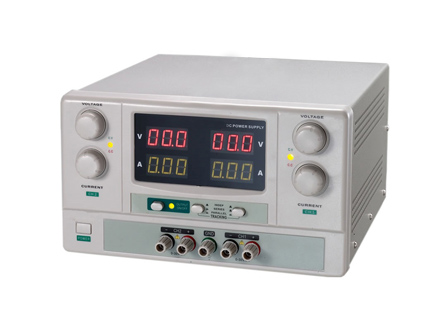DC Power Supply: The Heart of Electronics
2025-04-15
In the world of electronics and electrical engineering, one of the most crucial components is the DC power supply. Whether you're building gadgets, designing circuits, or working in a laboratory, the need for a stable and reliable power source is constant. This blog will explore what a DC power supply is, its importance in various applications, and why it's a fundamental tool in electronics.
What is a DC Power Supply?
A DC power supply is an electronic device that provides a stable output of direct current (DC) electricity. Unlike alternating current (AC), which reverses direction periodically, DC provides a constant flow of electric charge in one direction. This consistent flow makes DC ideal for powering most electronic devices, from small gadgets to large industrial systems.
The main role of a DC power supply is to convert AC power from the electrical grid into a controlled and regulated DC output. It ensures that the voltage and current are stable and can be adjusted to meet the specific requirements of the connected device or circuit.
Types of DC Power Supplies
DC power supplies come in various types and configurations, each designed for specific applications. Some of the common types include:
1. Linear Power Supply: This type of power supply uses linear regulators to maintain a constant output voltage. Linear power supplies are known for their simplicity and low noise levels, making them ideal for sensitive applications such as audio equipment, test equipment, and high-end laboratory devices.
2. Switching Power Supply: A switching power supply uses high-frequency switching components to convert AC to DC more efficiently. This type is smaller, lighter, and more energy-efficient than linear power supplies. They are commonly used in computers, telecommunications equipment, and consumer electronics.
3. Programmable Power Supply: A programmable DC power supply allows users to set and adjust the output voltage and current remotely, often via a computer interface. These power supplies are widely used in testing and development environments where precise control is needed for various devices and circuits.
4. Uninterruptible Power Supply (UPS): While not typically used for continuous operation, a UPS is a type of DC power supply that provides backup power in case of electrical failure. It’s commonly used for computers, servers, and critical equipment to prevent damage from power outages.
How Does a DC Power Supply Work?
A typical DC power supply works by first taking in AC power from the mains electricity source. This AC power is then converted into DC using a rectifier circuit, which consists of diodes that allow current to flow in one direction only. After rectification, the DC power is smoothed out to reduce ripple using capacitors.
Once the power is converted to DC, the voltage and current are regulated to ensure that the output remains stable and within the desired range. In a linear power supply, this is done using a series of voltage regulators, whereas in a switching power supply, it is achieved by rapidly switching the power on and off, adjusting the duty cycle of the switches.
Key Features of a DC Power Supply
1. Voltage and Current Adjustment: Most DC power supplies allow users to adjust both the output voltage and current. This feature is essential for testing devices with different voltage and current requirements.
2. Output Stability: A high-quality DC power supply ensures that the output voltage and current remain steady, even when the load on the device changes. This stability is crucial for preventing damage to sensitive electronics.
3. Overcurrent and Overvoltage Protection: Many modern DC power supplies come with built-in protections, such as overcurrent and overvoltage protection. These features prevent the device from being damaged in case of a short circuit or when the output exceeds safe levels.
4. Digital Displays and Controls: Some DC power supplies feature digital displays that show real-time voltage and current readings. These are especially useful for precise measurements during testing or experiments.
5. Efficiency: Efficiency is a critical factor, especially in applications that require constant use. Switching power supplies are typically more efficient than linear ones, as they generate less heat and waste less energy.
Applications of DC Power Supplies
DC power supplies are used across a wide range of industries and applications. Some of the key areas where they play a vital role include:
1. Electronics Development and Testing: Engineers and technicians rely on DC power supplies for testing circuits, components, and devices. By providing a stable and adjustable power source, DC power supplies ensure that tests can be conducted under controlled conditions, leading to accurate results.
2. Battery Charging: DC power supplies are often used for charging batteries. They can be adjusted to supply the correct voltage and current to safely charge batteries of various sizes and types, from small lithium-ion batteries to large lead-acid batteries.
3. Manufacturing and Assembly: In manufacturing processes, especially in industries like telecommunications, automotive, and consumer electronics, DC power supplies provide the necessary energy to assemble and test components before they are integrated into larger systems.
4. Laboratory Research: Laboratories that conduct research on new electronic technologies use DC power supplies to power test equipment, sensors, and prototypes. The ability to adjust the output precisely is essential for experiments where exact conditions are required.
5. Medical Equipment: Many medical devices, including diagnostic machines and imaging equipment, require a stable and reliable DC power source to operate safely and effectively. DC power supplies ensure that these devices function properly without interruption.
Choosing the Right DC Power Supply
When selecting a DC power supply, it's important to consider several factors:
- Voltage Range: Ensure the power supply can provide the required output voltage for your application. Some devices may require a specific range, so it’s important to choose one that can meet these needs.
- Current Rating: Make sure the power supply can deliver the appropriate amount of current for the device or circuit you're powering. An underpowered supply can cause instability, while an overpowered one could damage sensitive components.
- Regulation and Stability: Look for a power supply with good voltage and current regulation. Stability is key to prevent fluctuations that can affect the performance or longevity of the devices being powered.
- Portability and Size: If you plan to use the power supply in a mobile or confined workspace, consider the size and weight of the unit. Some models are designed for portability, while others are larger, rack-mounted units used for industrial or laboratory settings.
- Efficiency and Cooling: A more efficient power supply generates less heat and is less likely to require extensive cooling. Consider models with good thermal management to prevent overheating during prolonged use.
Conclusion
The DC power supply is a cornerstone of modern electronics, providing the necessary voltage and current to power devices, circuits, and systems. Whether you're working on prototypes, conducting experiments, or running industrial equipment, choosing the right power supply is essential for ensuring optimal performance and longevity. With various types available, it's easy to find a DC power supply that meets the specific needs of your project or application. The versatility, stability, and reliability of DC power supplies make them indispensable tools for anyone working with electrical and electronic systems.



